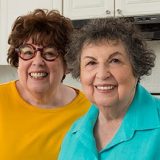During this most holy time of Jewish holidays, I find myself thinking of the apple tree my maternal grandfather, Joseph Katziff, planted in the front yard on Sea Foam Avenue in Winthrop, Mass., where we grew up.
I have always associated apples with the Jewish New Year because they are familiar to the season; they can be sweet, symbolizing the sweetness of the New Year, and because of Zadeh Katziff’s apple tree.
There were two yards at the front of the three-decker that Zadeh and Bubbe Katziff bought in 1919. It was a big jump from living behind the store on Marion Street in East Boston, and Bubbe wanted her children to live in a house with grass in the front.
Depending upon how you viewed or entered the house, the apple tree was planted in the yard either to the right or the left of the front door in the middle.
The apple tree lived in harmony with the white lilac bush that Zadeh had planted in the adjoining front yard. The lilac bush became a “tree” as it grew in breadth and height and honored us every spring with its sweet-scented blossoms.
The apple tree, however, had a life of its own, and it spent almost 50 years residing on Sea Foam Avenue. The apple tree flourished. It grew and grew until it reached almost to the third floor. Living on the second floor, we had a grand view of the apple tree from our front porch. We rejoiced in its early green buds in spring. We gloried in its white and pink blossoms and their fecund scent, which greeted us in late spring and early summer.
Sitting on the second-floor front porch, we watched as the white petals started to fall all over the yard and the front walk. I used to refer to them as “summer snow.” Then came the time of autumn maturity when the infant apples grew into lovely smelling round fruit with one cheek green and one cheek red where the sun had kissed them. For three seasons, the apple tree spread its branches, first heavy with blossoms, then heavy with fruit.
During the changing seasons, neighbors and passers-by often stopped to view the tree and comment on its beauty and later on its fruit-laden branches.
In late September or early October came the harvest. Some of the apples we could reach, and we picked those. Others we gathered after gently shaking its branches. There were enough apples for everyone on Sea Foam Avenue to receive three pounds in brown paper bags saved from the grocery store.
Then came the aroma of apples baked into pies, cakes, bread puddings and sauces. In our house, we enjoyed the apples in our mother’s apple strudel, Dutch apple cake and famous apple pie—a piece of which our father always paired with a slice of cheddar cheese, and we adorned with a scoop of vanilla ice cream from Playstead Pharmacy.
Usually this personal harvest occurred just before Rosh Hashanah, the Jewish New Year. We loved the scent of apples being baked in the homes of our neighbors. I believed that the yearly apple gathering and giving event from our tree contributed to a sense of harmony on our street. Minor disagreements evaporated as the women baked with our apples in their home kitchens and their husbands and children ate the fruit of our tree out of hand or in their wife or mother’s culinary creations.
The apples from our tree tasted like no other apples. They were sweet, but with a hint of sour, and the taste of those apples became a metaphor of life to us—sweet, but sometimes not so sweet. I never knew what variety the apples were, and I have never tasted any that matched their flavor.
During the 1970s, our apple tree began to change. It was weary and old, and its blossoms were sparse and its apples were few. The tree was dying and it was time for us to bid it farewell. We summoned a tree surgeon who skillfully cut down our apple tree. Its branches were bundled together and carted off. We looked at the empty yard, and we felt a sadness that we couldn’t quite explain. Tears were shed and we were silent as we realized a part of our lives had ceased to exist. The tree had grown older but so had we.
We still baked pies and strudels and Dutch apple cakes, but we bought our apples, and the taste was never the same. We realized that the tree had lived its life to the fullest, and it was time for it to leave us.
Its neighbor, the white lilac, began to fail. A month after we had the apple tree removed, we made another call to the tree surgeon. We said farewell to the white lilac that could no longer take part in the putting together of the childish bouquets we had made in honor of Memorial Day.
The front yards were bare. The wrought-iron fences with their curlicues remained. We planted a hydrangea bush in one corner of the yard, but we never forgot the apple tree that was so much a part of our lives.
Originally posted on Facebook. Follow The Food Flirts here.
This post has been contributed by a third party. The opinions, facts and any media content are presented solely by the author, and JewishBoston assumes no responsibility for them. Want to add your voice to the conversation? Publish your own post here. MORE



